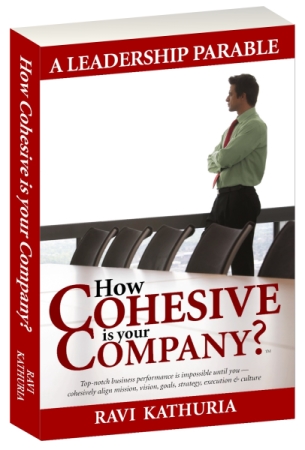
In companies, we often miss the obvious. We are so caught up in the way we have done things, we miss the big picture.
Growth Challenge
The CEO of a large technical consulting firm with hundreds of partners was struggling to generate growth. The firm was profitable, but it had reached a plateau in growing revenues.
The CEO engaged me to understand his firm and implement my Cohegic MethodTM to help him generate faster growth.
Assessment
As I studied the firm, I found the partners had excellent relationships and reputation in the marketplace. They were confident and knowledgeable, experts in their own sub-areas. They were also proud. Each partner believed — a little too much — in their own capabilities and ability to control their destiny.
Partners had their individual practices and teams. They did business development, found clients, serviced them, and managed their own P&L. It did make the company profitable. The partners were working as hard as they could. It was not possible to wring more growth from the existing structure and culture.
Page 1 of 4
Strategy For Growth
How would you generate more growth? Could you generate growth under the current structure?
The Cohesion Facet of the Cohegic MethodTM requires that the organization design and corporate culture are in cohesive alignment with the goals and strategy of the organization. I could see this was lacking within the company. It would require fundamental changes.
As I thought about the goal to achieve growth, I remembered — You have to make the whole greater than the sum of the parts. I decided to make it the main thrust of the strategy to achieve the growth goal.
Cohesion
The Cohegic Method requires every strategy to be linked to a goal. Often, companies develop strategies in a vacuum without linking them to a goal. These strategies then wither on the vines. You will see ahead, why this seemingly simple linkage is critical for change management.
Engine Facet
The Cohegic Method’s Engine Facet covers:
- Work Processes & Systems
- Organization Design & Skills
- Corporate Culture
The Engine Facet of this company was not compatible with where the company wanted to go.
The corporate culture was driven by individualism. The partners were lone wolves. They ate what they killed. They (and their teams) operated as individual units, separate from the other partners, often competing internally with other partners for prospects and internal resources. The senior partners threw their weight around and bullied the other teams.
The company’s organization design and corporate culture were not going to produce greater growth. In fact, they were the obstacles to growth.
“Unless the culture of individualism was replaced,
the company could not create value
greater than the sum of the parts.”
Skills Development & Rewiring Habits
Along with that, there was another big issue.
The partners were technical experts, they were not business development experts. Over the years the partners had built strong relationships, however, the relationships were at the middle management level in client organizations. They were not comfortable presenting to senior executives. Their selling skills and perspectives would need to be upgraded.
Recommendation
To generate growth, I recommended to the CEO, management team, and senior partners, they needed to pursue larger projects. They would need to sell to executives higher up in the client organizations and deliver projects that brought together expertise across several partner teams. These projects would command premium pricing and be longer in duration. They could become the growth avenue for the firm.
Pushback
The pushback was immediate, “Who would sell those projects?”
Large projects take time to sell and involve greater risk. Partners have one intense focus — Billability. They are operational and tactical in focus. Business development of a large project takes time, and it can erode billability in the short term.
Page 2 of 4
New Team
I recommended they create a Sales Origination Team (SOT) that would pursue high-dollar projects. The team would be staffed by:
- Professional sales executives
- High-profile subject-matter experts
- Administrative staff
Some of the partners would be candidates for roles in the SOT.
Resistance to Change
The recommendation was not accepted well. Several partners raised objections,
- “We have never done it this way!”
- “This will not work.”
- “Our clients will not like this!”
“We are so caught up
in the way we have done things,
we miss big opportunities for growth.”
Senior partners were afraid to lose their autonomy. They were rulers of their fiefdoms. If the change was implemented, they would be forced to be part of an organization and have to work together.
I pointed out that unless the culture of individualism was replaced and partners worked together, the company would not create value greater than the sum of the parts.
The wolves would need to hunt as a pack to take down bigger prey.
A Choice to Make
I stressed to the CEO and the management team that their organization design and culture, which are part of the Cohegic Method’s Engine facet, did not match the high-growth goal and associated strategy. They had a choice, either discard the goal, or make the necessary Engine changes.
The CEO was under pressure from the private equity investors to drive growth. The investors wanted an exit and to sell the firm in three years to the next round of investors. To increase the valuation, they needed growth. The CEO chose to press for the changes.
Creating the Team
I decided they needed someone from within the organization to lead the SOT as opposed to bringing in someone from the outside. It would increase the chances of success.
I interviewed many of the firm’s partners and then identified a senior partner who was a strategic thinker. He recognized the cultural and structural problems. He was respected and influential in the firm and had a stellar reputation outside the firm. The idea was he would sell the concept and get buy-in within the organization. This senior partner was also a strong individual. He would be able to withstand attacks against the concept and make sure the execution of the idea was carried out without internal hindrances.
The Sales Origination Team (SOT) was created. It was staffed within four weeks, primarily from people within the company since it was expedient to use internal resources. We hand-picked partners and other team members who were more mature and experienced than the average partner. People who could, with the proper sales coaching, think beyond the obvious and engage the client executives in a larger discussion.
Implementing the Steps
Then we developed the Sales Strategy, Marketing Strategy, Value Proposition Strategy, and Delivery Strategy. We also developed a compensation plan for members of the SOT, and updated the plan for the partners and teams that were not part of the SOT.
Sales Process
The Cohegic Method requires work processes to be derived and aligned with the strategy.
Page 3 of 4
We developed a new and detailed Sales Process that was cohesively aligned with the Sales Strategy.
Sales Coaching
Since the team did not have professional sales experience, I took the team through Sales Coaching with the goal to rewire their techniques, habits and mindsets. Selling to senior executives is very different from selling to middle management. Also, the size and scale of the projects meant the sales approach had to be different from what they were accustomed to. They needed to learn a new way of selling.
Sales Metrics
In many companies, sales metrics are lagging indicators. These traditional metrics do not provide strategic insight into the sales pipeline. We developed sales metrics that would measure the leading indicators to tell us in detail whether the sales strategy was succeeding. It is important to pick the right metrics.
Results
Once the initial resistance wore off, the creation of this team began to generate a lot of energy and excitement. The team was unshackled from billability pressures and was able to fully devote themselves to business development.
In less than three months, they started landing projects that were twice the size of what a partner was bringing in on average. More importantly, their pipeline grew much larger. It took seven months for them to win the first large project that was nine times larger than the average project. After that, there was no looking back.
The creation of the new Sales Origination Team paid off and allowed them to pursue projects with a greater scope.
Milestones were met quicker.
Relationships were built faster.
Revenues doubled and the perception of the company in the marketplace grew dramatically.
It was a huge win!
Your Organization?
Where does your organization stand? Are your organization design and corporate culture in cohesive alignment with your goals and strategies?
If you would like advice and guidance on how the Cohegic MethodTM can help your company perform at the next level, please contact Cohegic to set up a meeting with me.
Page 4 of 4
RAVI KATHURIA
Quoted in The Wall Street Journal, Barron’s, Forbes, and WorldNews, Ravi Kathuria is a recognized thought leader.
Featured on the BusinessMakers show, CBS Radio, and Nightly Business Report, he is the author of the highly acclaimed book, How Cohesive is Your Company?
Kathuria is the president of Cohegic, a management consulting, executive and sales coaching firm, and president of the Houston Strategy Forum.
A thought provoking and vivacious speaker, he has captivated audiences at conferences, events and corporate meetings.
Share this Post


